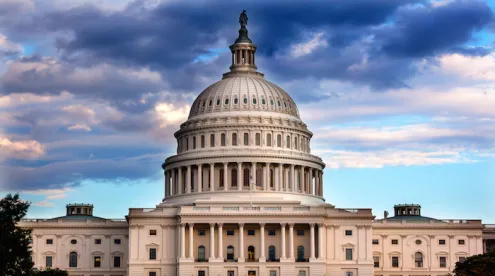Update: On the evening of March 18, 2020, the President signed this bill into law.
Earlier this week we detailed Congress’ second sweeping legislative package in response to the COVID-19 epidemic. Since then, the House of Representatives passed a package of technical corrections. On the afternoon of March 18, 2020, the Senate passed the corrected legislation with a vote of 90-8. While the provisions around COVID-19 testing, food aid and unemployment insurance remain largely unchanged from earlier this week, the following details the updated paid leave and tax provisions that are expected to be signed into law by the President imminently.
The Families First Coronavirus Response Act contains leave provisions applicable to private employers with fewer than 500 employees, as well as some governmental employers. While the act will provide some important relief for individuals who are off work for reasons related to COVID-19 and would otherwise be without pay, the legislation was narrowed in scope from the original version that provided even further expanded Family and Medical Leave Act (FMLA) leave for purposes such as being required to stay home for virus containment purposes. The final version of the legislation provides the following leave benefits to employees of covered employers:
- Up to 80 hours (pro-rated for part-time employees) of paid sick leave, available for immediate use regardless of length of employment, if the employee cannot work (or telework) because he/she:
- Is experiencing symptoms of COVID-19 and seeking a medical diagnosis, which is paid at 100% and capped at $511 per day and $5,110 in the aggregate.
- Is subject to a government quarantine or has been told by a health care provider that he or she should self-quarantine due to COVID-19, which is paid at 100% and capped at $511 per day and $5,110 in the aggregate (or assisting an individual who must quarantine/self-quarantine for those reasons, which is paid at 2/3 the employee’s rate and capped at $200 per day and $2,000 in the aggregate).
- Is caring for a son or daughter if his/her school/child care provider is unavailable due to COVID-19, which is paid at 2/3 the employee’s rate and capped at $200 per day and $2,000 in the aggregate.
- Is experiencing any other substantially similar condition specified by the Secretary of Health and Human Services, which is paid at 2/3 the employee’s rate and capped at $200 per day and $2,000 in the aggregate.
- Up to 12 weeks of expanded FMLA leave, unpaid during the first 10 days (which are practically covered by 1. above), and then paid at 2/3 the employee’s rate (but capped at $200 per day and $10,000 in the aggregate) and available to anyone after 30 days of employment for time to care for the employee’s son or daughter if the child’s school/child care provider is unavailable due to COVID-19 and the employee is unable to work (or telework).
Other key points from the act are as follows:
- Covered employers must post a notice to employees about their rights under this act (at least as to 1.) once the Department of Labor prepares it.
- The legislation would expire on December 31, 2020, and unused time would not carry over from one year to the next.
- The act would become effective within 15 days of enactment, and the Secretary of Labor is charged with issuing implementation guidelines within that period of time.
- An employer may elect to exclude health care providers and emergency responders from the leave benefits.
- The Secretary of Labor is empowered to exempt small businesses (fewer than 50 employees) from the leave benefits if the requirements would jeopardize the viability of the business as a going concern.
The act provides tax credits to employers to help cover the benefit cost. The credit is computed on a quarterly basis, and the employer would take the total amount of qualified sick leave wages paid (in the first two weeks) and qualified family leave wages paid (in the following 10 weeks) during that quarter, and such amounts would be a credit against the employer-portion of social security taxes (at 6.2%) that would otherwise be due from the employer. Any excess amounts above and beyond the employer-portion of social security taxes would be refunded as a credit (as if the employer had overpaid the employer-portion of social security taxes for that period).
In effect then, the government will provide a credit against the employer-portion of the social security taxes that would otherwise be due from the employer as follows:
- Against the social security taxes due for the given period, and then
- As a refund as if the excess was an overpayment by the employer of the employer-portion of the social security taxes.
For purposes of computing the amount of the credit, there are two relevant periods:
- First two weeks (this credit relates to qualified sick leave wages paid): The credit amount depends on whether the employee is sick or is caring for a sick family member or providing childcare to the employee's child:
- Employee Sick: The credit is the lesser of the daily wage or $511 per employee, per day, for 10 days.
- Providing Care to Family Member/Childcare to Child: The credit is the lesser of the daily wage or $200 per employee, per day, for 10 days.
- Next 10 Weeks (this credit relates to qualified family leave wages paid): The credit is the lesser of the daily wage or $200 per employee, per day, with the credit capped at $10,000 per employee for a given calendar quarter.
In addition to the credits provided for qualified sick leave wages and qualified family leave wages, the legislation also provides for a credit to employers for certain qualified health plan expenses that are allocable to such qualified sick leave wages or qualified family leave wages.






 />i
/>i

